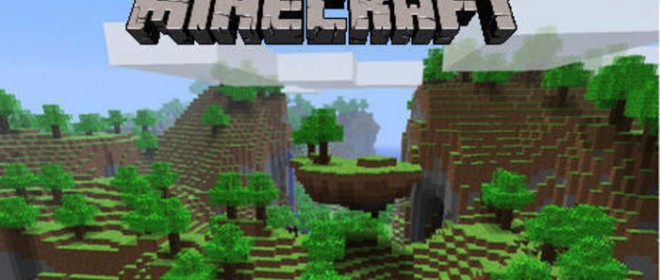
2012 really was Minecraft’s year. Well, Minecraft and the Mayan calendar. Why was 2012 all about Minecraft? There’s the obvious answer: the PC and iOS versions released at the tail end of 2011 while the Xbox version released in Spring of 2012, but that answer is no fun. How is it that Minecraft has hooked so many people (including myself) with all its blocky, scary, and sometimes buggy glory?
I play the PC version of Minecraft, as does my husband. It is a depressing experience if you have a crummy computer and a terrible internet connection, since playing with other people becomes a laggy and frustrating endeavor. Often our time spent on the PC version was in complete isolation. You lose track of time down in the dark, winding mines, with the constant threat of lava and the paranoia that you’ll hear a hiss behind you at any moment. Intermittently, the soft, pleasant music distracts you from swinging your pickaxe around. Over time, you will come to develop strong sentimentality for that music. It was your only bit of light and goodness down in the mines. An atmospheric torch in the darkness that often fills the game.
Playing this way, you’ll make some amazing things and have no one to show – or those who see your creations can’t appreciate all the work that went into building a great road of cobblestone, with bridges and tunnels through mountains, to link your two towns, or crafting your first full set of diamond armor.
Those who were there in the early alpha and beta days of Minecraft remember all of the non-functional items, the world holes, the duplication and disintegration glitches, and the sheer ugliness of it all. It was a rough start, but something about the experience was captivating, and haunting, and introspective, and beautiful. It might seem unfair to call Minecraft ugly, but without texture packs, it really is. It’s a blocky mess. Lava looks like cheese, gravel looks like vomit, and the faces of the pigs are disturbing. The aesthetic of the world takes some getting used to, and a few pretty texture packs can serve as a salve to the homeliness.
When I heard that an Xbox 360 version was coming out I was delighted. Now I could play with my friends while talking over a headset, and hear them shriek after they encounter the abilities of a creeper. The multiplayer aspect of Minecraft XBLA opened a whole new style of play for me. I spent hours gaming with my family and friends, eventually building a gigantic castle, a hot air balloon, and a pirate ship, and carving a dragon into a mountainside.
I had a lot of fun playing it, but why? Minecraft’s music is the first hint. It has a digital lullabye feel to it, giving your brain this instant feeling of nostalgia and comfort. It is familiar and new at the same time. It shouldn’t work with a game where you’re constantly being murdered by zombies, spiders, creepers, and skeletons, but it does. The mobs are a constant challenge, giving the game a survival-horror feeling. Every Minecraft player has had that night where they dug a hole or built a crummy hut and sat in it all night hearing zombies groan and the xylophone tones of skeletons edging closer. The logic behind the appearance of monsters in the dark (the most of them being dispatched by light) is one that every person has internalized since they were children. We all know that there are scary things in the dark, as we’ve all had those sleepless nights where we wondered if the creature under our bed or in our closet would eat us. You make them go away with a nightlight, because evil things don’t like light. Simple enough.
Minecraft – Volume Alpha by C418
The building aspect of Minecraft is difficult. It isn’t Dark Souls difficult (meaning unnecessarily hard and unbalanced as a way to give players a false sense of achievement) but it certainly takes some getting used to. The PC version of the game doesn’t provide guidance or instruction, so you always have to keep a wiki tab open so you can remember how to make an iron bucket or figure out what mushrooms were for. The Xbox version lets you auto create objects as a clever way of adapting precise PC controls to a console controller. The building of objects is fun, but not because it is directionless. It is difficult to find materials, configure them in the correct way, and prepare the space for whatever you are building. Often, the things you make will be destroyed by creepers, lava, or TNT pranks. You learn to sigh, pick up your tools, and put everything back together, perhaps with some reinforcements or protection to keep the same things from happening again. As a player, you adapt to your environment and the challenges it presents. Ultimately, the game gives you the ability to make your wildest ideas real, as long as they fit within the parameters of the tools. And if you’ve spent any time on the internet, that means that the possibilities are limitless. Someone actually figured out how to make a working computer in Minecraft.
The game has gone through several updates that have upset many core players, but they overlook the potential of these updates. At first, the hunger bar looked like an unnecessary annoyance. Now I see that it serves as a way to encourage players to treat the game more like a role playing exercise. The game has added new monsters, new items to craft, and new modes of play. It is fun and inventive, but the core mechanic and core logic remain the same.
The industry might not recognize this, but kids are really good at figuring out how to do new things. They’ll ham-handedly put in quick time events or absurdly long tutorials, or meaningless achievements because they think they understand kids, but really, these aspects of a game serve as an expression of adult laziness. Kids are willing to experiment, make mistakes, and start over, which is why they always seem to have complete mastery over every new form of technology that comes their way while adults are still trying to figure out how to pronounce it. Minecraft meets players, both kids and adults, where they are. A lot of people will be bored by the game because they don’t get the point, but kids get it. This is a world where they can learn, build, and fight on their own. They understand the terms of the world, they understand the rules of the game, and they understand that there isn’t any real win state. Minecraft is a successful gaming interpretation of the best aspects of life.
Back to that soothing soundtrack by C418. The music is childlike and mature, old and digital, sweet and creepy. Minecraft gives players the chance to make a world they want, fight creatures that follow rules, and decide their own win state. It encapsulates the wonders of childhood and the freedom of adulthood all at once. It’s scary and open but sometimes lovely and beautiful.
The most exciting aspect of Minecraft is what it means to the next generation of gameplay. If a small team of dedicated and creative people could make a game that constantly improves, innovates, and redefines gaming, imagine what a slew of people who played that game will make.


